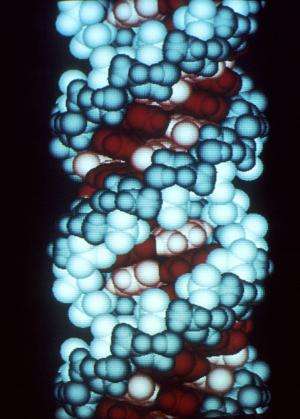Scientists fold RNA origami from a single strand

RNA origami is a new method for organizing molecules on the nanoscale. Using just a single strand of RNA, many complicated shapes can be fabricated by this technique. Unlike existing methods for folding DNA molecules, RNA origamis are produced by enzymes and they simultaneously fold into pre-designed shapes. These features may allow designer RNA structures to be grown within living cells and used to organize cellular enzymes into biochemical factories. The method, which was developed by researchers from Aarhus University (Denmark) and California Institute of Technology, is reported in the latest issue of Science.
Origami, the Japanese art of paper folding, derives its elegance and beauty from the manipulation of a single piece of paper to make a complex shape. The RNA origami method described in the new study likewise involves the folding of a single strand of RNA, but instead of the experimenters doing the folding, the molecules fold up on their own.
"What is unique about the method is that the folding recipe is encoded into the molecule itself, through its sequence." explains Cody Geary, a postdoctoral scholar in the field of RNA structure and design at Aarhus University. "The sequence of the RNAs defines both the final shape and also the series of movements that rearrange the structures as they fold."
"The challenge of designing RNAs that fold up on their own is particularly difficult, since the molecules can easily get tangled during the folding process. So to design them, you really have to imagine the way that the molecules must twist and bend to obtain their final shape." Geary says.
The researchers used 3D models and computer software to design each RNA origami, which was then encoded as a synthetic DNA gene. Once the DNA gene was produced, simply adding the enzyme RNA-polymerase resulted in the automatic formation of RNA origami.
To observe the RNA molecules the researchers used an atomic force microscope, a type of scanning microscope that softly touches molecules instead of looking at them directly. The microscope is able to zoom in a thousand times smaller than is possible with a conventional light microscope. The researchers have demonstrated their method by folding RNA structures that form honeycomb shapes, but many other shapes should be realizable.
"We designed the RNA molecules to fold into honeycomb patterns because they are easy to recognize in the microscope. In one experiment we caught the polymerases in the process of making the RNAs that assemble into honeycombs, and they really look like honey bees in action." Geary continues.
A method for making origami shapes out of DNA has been around for almost a decade, and has since created many applications for molecular scaffolds. However, RNA has some important advantages over its chemical cousin DNA that make it an attractive alternative:
Paul Rothemund, a research professor at the California Institute of Technology and the inventor of the DNA origami method, is also an author on the new RNA origami work. "The parts for a DNA origami cannot easily be written into the genome of an organism. RNA origami, on the other hand, can be represented as a DNA gene, which in cells is transcribed into RNA by a protein machine called RNA polymerase." explains Rothemund.
Rothemund further adds, "The payoff is that unlike DNA origami, which are expensive and have to be made outside of cells, RNA origami should be able to be grown cheaply in large quantities, simply by growing bacteria with genes for them. Genes and bacteria cost essentially nothing to share, and so RNA origami will be easily exchanged between scientists."
The research was performed at laboratories at Aarhus University in Denmark, and the California Institute of Technology in Pasadena. Ebbe Andersen, an Assistant Professor at Aarhus University, who works on developing molecular biosensors, lead the development of the project.
"All of the molecules and structures that form inside of living cells are the products of self-assembly, but we still know very little about how self-assembly actually works. By designing and testing self-assembling RNA shapes, we have begun to shed some light on fundamental principles of self-assembly." says Andersen.
"The primary application for these molecular shapes is to build scaffolds for arranging other microscopic components, such as proteins, into groups that allow them to work together. For example, using the scaffolds as a foundation to build a microscopic chemical factory in which products are passed from one protein enzyme to the next." Andersen explains.
More information: A single-stranded architecture for cotranscriptional folding of RNA nanostructures, Science 15 August 2014: Vol. 345 no. 6198 pp. 799-804. DOI: 10.1126/science.1253920
Journal information: Science
Provided by Aarhus University




















